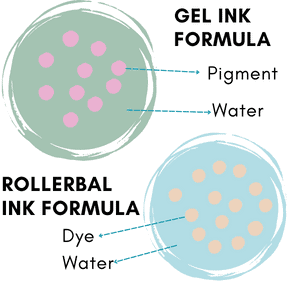Whether you’re jotting down school notes, writing in your journal, or making quick sketches, you have probably considered choosing between two popular pen options: gel pens vs rollerball pens.
If you look into these writing tools, you’ll see they have distinct characteristics and advantages. But which pen is better? How do they differ from one another? Read on to determine which pen type is the best for your needs and preferences.
Table of Contents
A Quick Overview
| Features | Gel Pens | Rollerball Pens |
| Ink Type and Ease of Flow | Water-based gel ink | Liquid (water-based) ink |
| Writing Experience | Smooth, vibrant colors; ideal for precise and thinner strokes | Smooth, consistent lines; requires less pressure when writing |
| Paper Bleed and Drying Time | Longer drying time; may smudge easily and bleed through thin paper | Quick-drying; may bleed through low-quality papers |
| Line Widths | Available in extra fine, fine, medium, and broad or bold line widths | Available in extra fine, fine, medium, and broad or bold line widths |
| Barrel Type | Often made of plastic; offered in a wide variety of barrel designs | Often made of metal; sleek design |
| Color Selection | Available in a vast array of bold colors | Limited color options |
| Cost | Generally affordable | Typically more expensive |
What Are Gel Pens and Rollerball Pens?
1. Gel pens
Gel pens use water-based gel ink, which is thicker and more opaque than standard liquid ink. The tiny metal ball rotates and distributes the ink smoothly and constantly as the pen glides across the paper, producing a smoother, consistent line.
Furthermore, gel pens have a refillable cartridge, dispensing rich ink with the efficiency of a well-oiled mechanism.
They provide a consistently seamless writing experience, making them ideal for daily use and producing eye-catching designs.
2. Rollerball pens
Rollerball pens dispense water-based or liquid ink continuously through a small ball at the pen’s tip. The ball gently rolls all over the paper, releasing ink and creating a dynamic line as it travels.
This produces a more fluid, expressive line with a subtle “wet” feel. Besides the professional and high-quality writing experience, rollerball pens use smooth and consistent ink flow that does not require a lot of pressure when writing.
Hence, they are a great option for users who want to reduce hand strain.
Breakdown of Their Features and Key Differences
1. Ink type and ease of flow
Gel pens utilize ink that is thicker and more viscous compared to what is used in rollerball pens. This implies that gel pens generate richer and more vibrant lines. Gel pen ink is also water-resistant, making it excellent for usage on papers or artwork that may be subjected to moisture.
Rollerball pens, however, utilize water-based ink that is thinner and more liquid than gel ink. These liquid ink rollerball pens are henceforth more suited for writing that demands a lighter touch as well as a gentler movement.
2. Writing experience
Gel pens render a more tactile writing experience due to their thick and bold ink. Hence, they are suitable for users who want to control their pens precisely, resulting in accurate and sharp lines.
Furthermore, as gel pens are recognized for producing lively and playful colors, they are popular among users looking to add a splash of color to their writing or drawing.
Meanwhile, rollerball pens provide a more comfortable writing experience. The smooth-flowing ink demands less pressure when writing, making them more pleasant to use for extended durations.
For instance, many professionals appreciate using a Parker rollerball pen for its effortless, sophisticated, and high quality writing experience.
3. Paper bleed and drying time
Gel pens take longer to dry than rollerball pens. If you’re not careful, they can smear or smudge easily on paper. Since they produce thick and rich ink, gel pens tend to bleed through paper, especially low-quality or thin paper types.
Rollerball pens have free-flowing and thinner ink that dries quickly, preventing messy ink smears. However, they may still bleed through low-quality papers.
4. Line widths
Both gel pens and rollerball pens are available in various line widths. They are typically available in different point types:
- extra fine or fine (0.38 mm, 0.5 mm, 0.4 mm, 0.6 mm)
- medium (0.7 mm to 1 mm),
- broad or thick ( 1 mm, or higher)
5. Design and barrel type
Gel pens typically have a thicker barrel, which provides a more comfortable grip and lessens hand fatigue during long writing sessions. A textured grip, a clip for attaching to a notebook or shirt pocket, or a retractable tip for convenient storage are all options for most gel pen barrels.
However, rollerball pens frequently feature a lighter and thinner barrel, making them especially ergonomic for persons with smaller hands or those writers or artists who want a more sleek writing instrument. The barrel can also be built of different materials like plastic, metal, or wood, giving users a variety of design possibilities.
6. Color selection
Both gel pens and rollerball pens come in a variety of colors such as metallic, neon, and pastel selections. Nevertheless, due to the thickness of the ink, gel pens generally offer a greater color palette and may offer more vibrant and opaque options.
Because of the nature of the liquid ink, rollerball pens may also provide more subtle and complex color options, but not as many as gel pens.
7. Cost
Rollerball pens are usually more expensive than gel pens because of the intricate nature of their ink formulation and high-quality writing experience.
However, that is not always the case, as prices may fluctuate depending on the brand, variant, quality, and capabilities.
- For example, a 4-piece set of uni-ball Impact Gel Pens costs nearly $11 compared to the 4-piece set of Rollerball Pens from the same brand, which only costs about $7.
- But it is the other way around with other variants, where an 8-piece set of uni-ball Vision Rollerball Pens costs nearly $15, which is more expensive than an 8-piece uni-ball 207 Retractable Gel Pens at only about $13.
Professional and popular brand options like Parker also significantly impact the price range.
- For instance, a single Parker IM Rollerball pen comes at a hefty price tag of around $28, while an 8-pack of Pilot G2 Premium Gel Pens will only cost around $12, which is still a much cheaper option.
Even so, both types of pens have affordable options, making them accessible to writers, artists, and users.
Pros and Cons
1. Gel pens
- Produces bold and vibrant colors
- Extremely smooth writing experience
- Water-resistant ink
- Comfortable grip
- Can produce fine and precise lines for detailed work
- Long drying time
2. Rollerball pens
- Smooth and consistent writing; no skipping
- Lightweight
- Quick-drying ink
- Excellent for producing precise lines and making complex details
- More affordable
- Ink may slightly bleed through paper
Best Examples of Gel Pens
- Uniball Impact Gel Pen
- Pilot G2 Premium Gel Pen
- BIC Gel-ocity Gel Pen
- Paper Mate InkJoy Gel Pen
- Uni-ball Jetstream
Best Examples of Rollerball Pens
- Uniball Vision Rollerball Pen
- Parker IM Rollerball Pen
- Pilot Precise V10 RT Retractable Rollerball Pen
- SHARPIE Rollerball Pen Arrow Point
- Arteza Rollerball Pen
Frequently Asked Questions
Is gel pen better than rollerball?
This question has no one-size-fits-all answer because it primarily depends on personal preference and writing demands.
Gel pens provide brighter and more vivid colors, but they are more vulnerable to skipping and smudging.
Meanwhile, rollerball pens provide a comfortable and stable writing experience but may not be as colorful as gel pens. It is best to try both types and evaluate which one best meets your needs and interests.
However, if you want the smooth and consistent writing experience of rollerball pens with the bold and vibrant colors of gel pens, you can find gel ink rollerball pens such as the Pilot G2 Premium Gel Pen.
These gel rollerball pens are meant to provide the best of both worlds and are a good choice among writers who prefer the simplicity of a rollerball pen combined with the distinct properties of gel ink.
Is gel pen a rollerball pen?
No, gel pens and rollerball pens are not the same. Gel pens contain water-based gel ink that glides seamlessly across the paper, whereas rollerball pens are using liquid ink delivered via a ball mechanism.
Is rollerball pen the same as ballpoint pen?
When talking about a rollerball vs a ballpoint pen, take note that they are two different types of pens. Rollerball pens use liquid or water-based ink whereas ballpoint pens use thick oil-based ink.
What is the key difference between rollerball, ballpoint, and gel pens?
The type of ink used in rollerball vs ballpoint vs gel pens is one key feature that sets them apart. Simply put, rollerball pens use water-based ink, ballpoint pens use oil-based ink, and gel pens use water-based gel ink.
Conclusion
When deciding between gel pens vs rollerball pens, take into account the ink type, paper bleed, available line weights, writing experience, barrel type, color selection, and cost.
Gel pens produce vivid colors, whereas rollerball pens produce a smooth and stable writing experience.
The decision between rollerball vs gel pens depends on one’s personal preferences as well as the intended application of the pen. However, one thing is certain: both of these pens allow you to express your creativity in the most delightful and fulfilling way imaginable.

Art has always been a part of my life; it influences my upbringing and later my career choice. For me, it is always a part of my parenting technique. So for whichever purpose that you come to art, you can start here with us.









